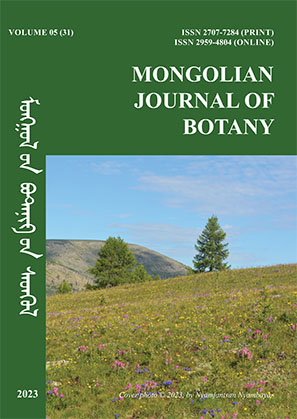Precipitation and temperature effect on changes in the Importance Relative Value (IRV) of dominant species in the Stipa gobica-Allium polyrhizum-Artemisia frigida community of Desert steppe
DOI:
https://doi.org/10.5564/mjb.v5i31.3262Keywords:
Desert steppe, Stipa gobica, Artemisia frigida, Allium polyrhizum, changes of Importance Relative Value, precipitation and temperature effectAbstract
This study was carried out from 2010 to 2022, conducted in the long-term monitoring research area of the vegetation community in the desert steppe of Dalanjargalan soum, Dornogovi province. We had been determined the Importance and Relative Value (IRV) of the dominant species in the vegetation community of desert steppe, which were Allium polyrhizum, Artemisia frigida, and Stipa gobica at the two different plots that were fenced and non-fenced. Therefore, we also examined the Pearson correlation between IRV of dominant species and climate (mean air temperature, total precipitation, and mean soil temperature by annual and growing season which were from April to October) and livestock. Our results showed that at IRV of Artemisia frigida was 2.8 times increased then became the primary dominant community in the non-fenced plots in 2022. On the other hand, the IRV of Allium polyrhizum decreased by 3.3 times, the IRV of Stipa gobica was 1.9 times increased then it became the primary dominant of the community in the fenced plot in 2022. The Pearson’s correlation analysis result showed that mean air temperature and soil temperature of the growing season were positively affecting on IRV of Stipa gobica, but negatively affecting on IRV of Allium polyrhizum. In the future, when the soil temperature during the plant growth period increases by 1oC the IRV of Allium polyrhizum tends to decrease by 0.03 times, while IRV of Stipa gobica tends to increase by 0.03 times will increase. Therefore, IRV of Stipa gobica will increase by 2.41 times which growing season mean air temperature will increase by 1oC. According to this, Stipa gobica, which is the main dominant of the desert steppe community, increases with a positive direct relationship to the average soil and air temperature during the growing season and tends to play the role of the main dominant of the community.
Цөлөрхөг хээрийн Агь-таана-говийн хялганат бүлгэмдлийн зонхилогч зүйлүүдийн үүрэг оролцооны үзүүлэлтийн өөрчлөгдөлд цаг агаарын үзүүлэлтүүдийн нөлөөлөл, цаашдын хандлага
Хураангуй Энэхүү судалгаа нь Дорноговь аймгийн Даланжаргалан сумын цөлөрхөг хээрийн Агь-таана-говийн хялганат бүлгэмдлийн мал бэлчээрлэлттэй болон бэлчээрлэлтгүй талбайн гол зонхилогчид болох Allium polyrhizum, Artemisia frigida ба Stipa gobica зүйлүүдийн бүлгэмдэл дэх үүрэг оролцооны өөрчлөгдлийг 2010-2022 оны өгөгдлийг ашиглан тодорхойлов. Тус зонхилогчдын үүрэг оролцооны үзүүлэлтэд цаг агаар болон малын тооны хамаарлыг статистик боловсруулалтаар шалгав. Үүний үр дүнд 2022 онд мал бэлчээрлэлттэй талбайд Artemisia frigida -ийн үүрэг оролцооны үзүүлэлт 2.8 дахин нэмэгдэн тэргүүн зонхилогч болж, Stipa gobica ба Allium polyrhizum нар дэд зонхилогчдын үүрэг гүйцэтгэж байгаа бол мал бэлчээрлэлтгүй талбайд Stipa gobica-ийн үүрэг оролцооны үзүүлэлт 1.9 дахин нэмэгдэж тэргүүн зонхилогч, харин Artemisia frigida ба Allium polyrhizum -ийн үүрэг оролцоо 3.3 дахин буурч дэд зонхилогчдын үүрэгтэй болсон байна. Мал бэлчээрлэлтгүй талбай дах Allium polyrhizum -ийн үүрэг оролцооны үзүүлэлт ургамал ургалтын үеийн хөрсний дундаж температураас урвуу сул хамааралтай, харин Stipa gobica-ийн үүрэг оролцоо нь ургамал ургалтын хугацааны хөрс болон агаарын дундаж температураас шууд хамааралтай байна. Цаашид ургамал ургалтын хугацааны хөрсний температур 1 градусаар нэмэгдэхэд Allium polyrhizum-ийн үүрэг оролцооны үзүүлэлт 0.033-аар буурах хандлагатай, харин Stipa gobica -ийн үүрэг оролцооны үзүүлэлт 0.03-аар нэмэгдэх хандлагатай бол ургамал ургалтын хугацааны агаарын дундаж температур 1 градусаар нэмэгдэхэд Stipa gobica -ийн үүрэг оролцооны үзүүлэлт 2.4 дахин нэмэгдэх хандлагатай байна. Үүнээс үзэхэд цөлөрхөг хээрийн бүлгэмдлийн үндсэн зонхилогч болох Stipa gobica нь мал бэлчээрлэлтээс хашиж хамгаалснаар ургамал ургалтын хугацааны хөрсний дундаж температураас эерэг шууд хамааралтайгаар нэмэгдэж, бүлгэмдлийн тэргүүн зонхилогчийн үүрэг гүйцэтгэх хандлагатай байна.
Түлхүүр үгс: Цөлөрхөг хээр, Говийн хялгана, Таана, Агь, зонхилогчдийн үүрэг оролцооны үзүүлэлтийн өөрчлөгдөл, цаг агаарын нөлөөлөл
Downloads
1950
References
Cottam, G., & Curtis, J. T. (1956). The use of distance measures in phytosociological sampling 1. https://doi.org/10.2307/1930167
Fernandez-Gimenez, M. E., & Allen-Diaz, B. (1999). Testing a non-equilibrium model of rangeland vegetation dynamics in Mongolia. In Journal of Applied Ecology (Vol. 36). https://doi.org/10.1046/j.1365-2664.1999.00447.x
Sasaki, T., Okayasu, T., Takeuchi, K., Jamsran, U., & Jadambaa, S. (2005). Patterns of floristic composition under different grazing intensities in Bulgan, South Gobi, Mongolia. Grassland Science, 51(3), 235–242. https://doi.org/10.1111/j.1744-697X.2005.00029.x
Д. Дагвадорж, З. Батжаргал, & Л. Нацагдорж. (2014). Монгол Орны Уур Амьсгалын Өөрчлөлтийн Үнэлгээний Хоёрдугаар Илтгэл.
И. Түвшинтогтох. (2014). Монгол орны хээрийн ургамалжил (Ч. Санчир & Ц. Түвшинжаргал, Eds.). Бэмби Сан.
И. Түвшинтогтох, Н. Нямбаяр, Б. Мандах, Д. Маньдарь, Ц. Түмэнжаргал, & Н. Баттогтох. (2019). Их Нартын Байгалийн нөөц газрын ургамлын аймаг, ургамалжил (И. Түвшинтогтох & Б. Мандах, Eds.). Адмон принт.
И. Түвшинтогтох, О. Мөнхзул, Ц. Түмэнжаргал, О. Хонгорзул, Г. Батзаяа, Н. Нямбаяр, & Ж. Аззаяа. (2019). Ургамалжлын урт хугацааны мониторингийн аргазүй (Шинэчилсэн).
И.Түвшинтогтох. (2005). Геоботаник (Э.Ганболд, Ed.). “Бэмби Сан” ХХК.
Н.Манибазар. (2000). Ургамлын дүймэн. Жемр
Downloads
Published
How to Cite
Issue
Section
License
Copyright (c) 2024 Purevdorj Khatansaikhan, Nyamjantsan Nyambayar, Indree Tuvshintogtokh, Bayasgalankhuu Lyankhua

This work is licensed under a Creative Commons Attribution 4.0 International License.
The authors grant the Mongolian Journal of Botany a license to publish the article and identify itself as the original publisher.

Articles in the Mongolian Journal of Botany are Open Access articles published under a Creative Commons Attribution 4.0 International License CC BY.
This license permits use, distribution and reproduction in any medium, provided the original work is properly cited.




